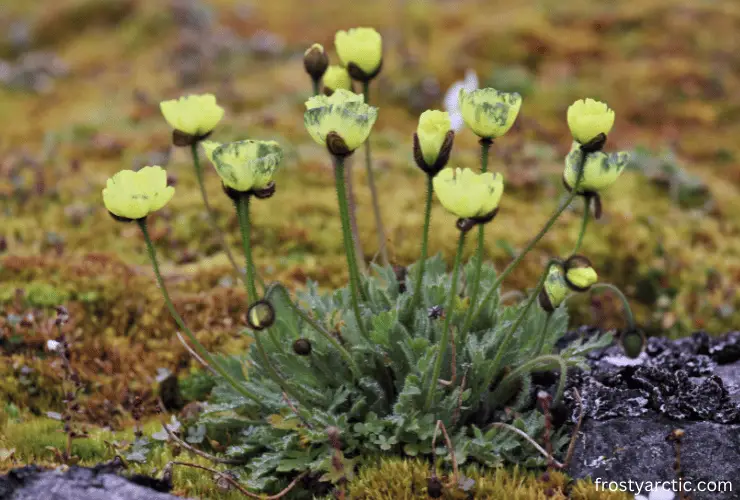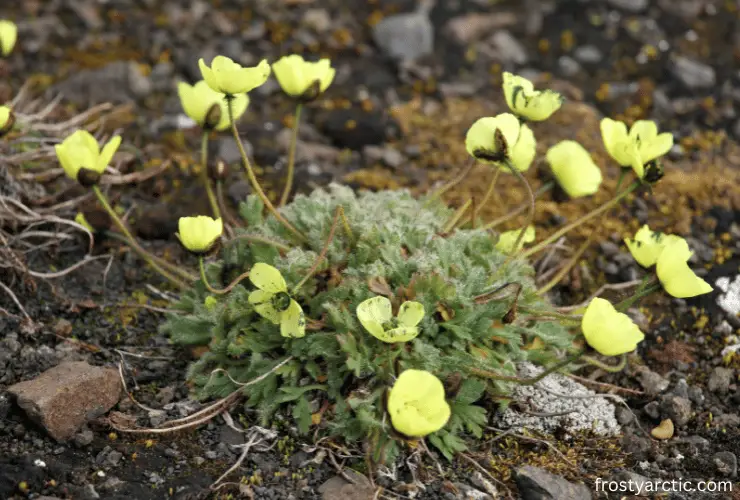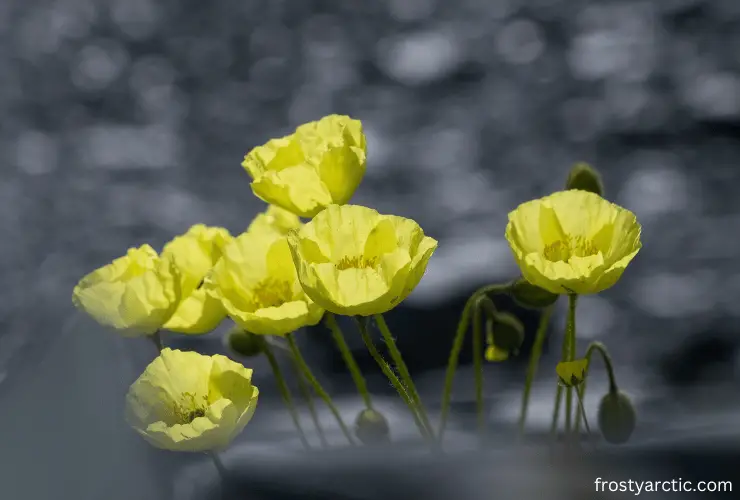Generally, Arctic plants are highly responsive to natural environment changes. A study predicted that around half of the Arctic territories with vegetation would change to a different physiognomic order in this century ~(Source). So, the cultivation of Arctic Poppy can be a game changer for the future.
The Arctic poppy (Papaver radicatum) adapted to the high Arctic areas. They are known as a common species in Europe, North America, and Asia. They have flowers that are solar tropic and are covered with black hair with surprisingly delicate white or yellow petals.
Arctic poppy also familiar as rooted poppy and yellow poppy.Let’s dive deep into the article to learn more about this plant in the family of Papaveraceae.
Arctic Poppy (At A Glance)
| Parameters | Details |
| Scientific name | Papaver radicatum |
| Root type | Hairy or tap |
| Height | 10-30cm |
| Soil type | Gravel, Sand, Rocky |
| Soil moisture | Medium or Dry |
| Soil pH | 4.3-7.2 |
| Sun exposure | Full sun |
| Suitable weather | Cold, moderate heat |
| Bloom color | White, Yellow |
| Bloom Time | June, July |
| Seed color | Brown, Dark Black |
| Benefits | Host plant, medicinal herb, deer resistant, attract butterflies, foods of arctic bumblebee. |
| Species | Papaver radicatum, Papaver nudicaule, Papaver lapponicum, Papaver dahlianum |
| Biome | Tundra |
What Is Arctic Poppy?
Arctic poppy grows in Greenland and is 10 to 30 cm long, with leaves and pubescent stems. The flowers are usually hard and rough. It blooms in June-July and is highly available in the fallen fields of Greenland.
These flowers constantly rotate towards the sun, tracking their movement through the air. Also, it attracts insects to the center of the flower. This perennial plant is stress tolerant and grows and reproduces in various environmental conditions.
Why Is It Called Arctic Poppy?
The Arctic region combines cold, treeless plains, hills, and mountains. It includes the northernmost parts of the mainland of Eurasia and North America and numerous islands in high latitudes, the largest of which is Greenland.
Most of the time, the Arctic is cold and dry in climate. Low temperatures and limited warmth due to the low position of the sun in summer and darkness in winter keep the Arctic frozen for much of the year.

The sun always seems to rise or set during the short growing season and disappear completely during arctic winters for extended periods.
The Arctic is supported by a partially decomposed layer of soil and organic matter that freezes year-round. It makes shallow roots smaller and averts larger plants, such as trees, from growing in the Arctic. Trees require a certain day length with a minimum temperature of 30°-50°F.
The poppy grown in the arctic has hairy stems and leaves that can withstand air. Also, the plant is around 14-30 cm with a shallow root system.
The flowers head towards the sun, and the cup-shaped petals absorb solar energy. They can produce their food through photosynthesis in the presence of sunlight like other plants. Also, they can continue this procedure under low light and temperature.
The above features of the Arctic poppy meet the requirement of an Arctic plant. Also, the poppy can easily survive in the Arctic. That’s why they are known as “Arctic Poppies.”
Where Do Arctic Poppies Grow?
Arctic Poppy is one of the northernmost plants in the world. It has a circular distribution in the Alpine and Arctic regions. Generally, the Arctic poppy grows in mountains, meadows, and dry river banks.
Keep in mind that Papaver radicatum is available in two populations. The first is available on alpine slopes, largely on rocks on loose slopes or crevices. They are known as primary populations. From there, water and snow can disperse seedlings to lower elevations.
This phenomenon establishes a secondary population on gravel and sandy banks near rivers or other disturbed lowlands. Therefore, individuals from the primary population may occur at high altitudes on wind-blown alpine slopes, sometimes in lower altitudes.
How Does the Arctic Poppy Survive in The Tundra?
Tundra is the harsh, cold, and dry ecosystem in the Arctic. People call it the arctic tundra. Also, there is the alpine tundra over the mountain peaks.
It is covered with snow almost every month, and strong winds blow in the tundra in summer. Also, the soil is scarce.
Moreover, plants that grow in the tundra have several key adaptations, such as hairy stems, size, and the capacity to reproduce rapidly during the short summer months. Now find out how the Arctic poppy survives in the tundra.
● Perennials
Due to a short growing time, most plants in the tundra are perennials. The Arctic poppy is also perennial. They spend many years accumulating and storing nutrients during each seed production period.
● Thermal efficiency
Arctic poppy flowers rotate slowly over long days to adapt to the cool weather. It faces towards the sun and produces extra energy for photosynthesis and reproduction.
● Physical characteristics
The stem hairs on the arctic poppy keep heat close to the plant body and protect it from the air. Also, the small waxy leaves prevent water loss in the arid environment.
The entire plant has black hairs, which may be an adaptation. It acts as a warning signal to keep predators away.
● Fast-growing cupped flowers
Arctic poppies have cup-shaped flowers to move with the sunlight. The calyx lets maximum sunlight fall on the flower’s center and helps it grow faster.
In general, the arctic poppy flower in early summer, so they can mature and seed in the shortest growing season.
● Shallow root
Because of the hard layer of ice at the bottom of the tundra, also called permafrost; the arctic poppy develops small roots. These shallow roots don’t go as deep as normal roots, but they let the plant absorb foods and attach itself to the soil.
As a result, you may find lichens, bushes, mosses, and flowers in that region, but you will not see a tall tree. Trees require deep rootlets, and permafrost interferes with these roots.
Is The Arctic Poppy Endangered?
Yes, the Arctic poppy is endangered. They become vulnerable and decrease their population due to global climate change.
In general, the arctic poppy is the northernmost flower. It’s highly available in the harsh arctic region, which lies at 84° north and circumpolar.
Due to climate change, the total ecosystem of the arctic is hampered. Methane emission is increased, and it deteriorates the permafrost. Lichen is broken, and thus, the food source is reduced.

On the other hand, mining and drilling well also hampers the permafrost. Therefore, all the plant and animal species, including the arctic poppy, are on the verge of extinction.
Is Arctic Poppy A Perennial?
A perennial plant is a plant that lasts for several years. They have a hardened physical character with a strong rooting system to survive adverse conditions. They produce more seeds to keep their foot on the earth.
The Arctic poppy is also a perennial plant as they have a shallow root system to uptake groundwater. They grow in the toughest and most extreme environmental conditions. In fact, this plant shows all the characteristics of a perennial plant.
What Does Arctic Poppy Look Like?
The arctic poppy is a perennial herb in the tundra with a height of around 14 cm. This plant is leafless, with a cup-shaped flower on each stem.
The flowers are generally yellow and turn to the sky to take sunlight for photosynthesis. Moreover, the petals of the flowers look like tissue paper and are very silky.
How Big Does an Arctic Poppy Get?
The arctic poppy is a beauty of the Arctic. It’s generally 14 cm long, but sometimes it may extend up to 30 cm. So, we can say that it’s moderate in size.
Arctic Poppy Adaptations
Arctic poppy is mostly popular for growing in extreme and adverse conditions. Let’s have a look at some features by which they adapt.
- The short Arctic poppy grows in groups and stays close to each other to shelter from the air.
- They remain close to the ground and collect their heat.
- Arctic poppies have bright flowers that attract insects and absorb heat.
- They bloom quickly due to their short growing season, around 60 days.
- Arctic poppies can grow from 27ºF to 36ºF (15ºC to 20ºC), which is colder than plants elsewhere.
- They turn towards the sun during the long summer days.
- Arctic poppies contain small leaves which look like a fern. The small leaves retain maximum plant moisture.
- A shallow root system lets plants grow in shallow soils since deeper soils always freeze through permafrost. The runners in their roots run along the surface. These rhizomes absorb water from a large area.
- Arctic poppies get energy from the sun. But their specialty is to do it at low light and temperatures.
- The seeds sit at the plant’s top to keep the wind blowing.
How Fast Does the Arctic Poppy Grow?
The Arctic Poppy is a perennial plant that is quite popular for its short growing season. It is propagated by seed. Seeds grow well at temperatures between 19-22°C.
The germination of a seedling may take only one or two weeks. Even its flowers are incredibly faster, it flowers within just 110-115 days from seed planting.
How Long Do Arctic Poppies Live?
Generally, a perennial plant lasts for 20 years with proper care and maintenance. But the short-lived perennial plant will last for around ten years.

As a perennial plant, the arctic poppy doesn’t last for so long. They disperse quickly but fade away soon. An arctic poppy may last for 1 to 2 years in suitable condition with proper care.
How Much Sun Does an Arctic Poppy Need?
Every living plant on the earth needs sunlight to live on the earth. Plants conserve the sunlight in their leaves and produce their food through photosynthesis.
Like other plants, the arctic poppy needs sunlight to produce its food. It needs partial or full sunlight.
Anyway, it has a special feature, as we mentioned earlier. The arctic poppy can live and produce its food at a minimum temperature and sunlight.
Is Arctic Poppy Edible?
Yes, arctic poppy is edible. You can eat both the leaves and seed of it.
Leaves are eaten cooked and are a good source of vitamin C. Also, they have good taste.
On the other hand, you can eat the seed by cooking or raw. The seeds contain opium and are quite pleasant to taste.
Remember that the arctic poppies have lower toxicity. So, eat it after ensuring the toxicity level is considerable.
Arctic Poppy Taste: Things You Need To Know
Arctic poppy tastes similar to spinach when taken from the leaves. The seeds taste like nuts and are very pleasant fruit.
Seeds may get stuck to your teeth, but it’s good for your health. That’s because it may contain calcium, magnesium, and fiber. Also, you can take the poppy milk or combine the poppy seed with your favorite dish.
What Is Arctic Poppy Used For?
The arctic poppy is useful to humans and the environment. Let’s have a look at it.
● Pollinator
The arctic poppy provides pollen for insects, including a bumblebee. Their impact on pollinators is great in early spring. At that time, other flower species are still dormant, but it is quite important for the pollinators.
● Dye
We can obtain beige and red dyes from flowers. Also, the flower pod produces brown and yellow dyes. So, it can be important for the dying industry.
● Human health
A species of arctic poppy (Papaver nudicaule) has anti-inflammatory activity. The extract reduces the LPS-induced inflammatory response by inhibiting the STAT3 and NF-κB pathways.
● Maintaining the ecosystem
The arctic poppy has an important effect on the tundra. It’s a good source of food for different arctic insects and herbivores. Also, it plays an important role in maintaining the arctic ecology.
What Animals Eat Arctic Poppy?
The tundra is home to many species of herbivorous mammals, including reindeer, squirrels, moose, arctic hares, lemmings, and sheep.
During summer, herbivores eat flowers, shrubs, and leaves. For food, they especially go with the arctic poppy plant and flower.
What Did Native Americans Use the Arctic Poppy For?
Native Americans use the leaves and seeds of the arctic poppy as a source of vegetables. They eat them by boiling them.
The petals act as a yellow dye and hairdresser. Native Americans use the pollens as cosmetics. Also, take the chopped plant as a tea for toothaches, headaches, and insomnia.
Is The Arctic Poppy a Medicinal Plant? Medicinal Use of Arctic Poppy?
The arctic poppies are generally popular for their rich compounds like calcium, fiber, protein, and antioxidants. Also, they have some medicinal value.
People use poppy extracts to relax the muscle to treat muscle cramps. Also, the poppy extracts can treat diarrhea. Poppy seed oils are used for chemotherapy and the treatment of fistula.
Moreover, the poppy has some other medicinal value. It’s good for your teeth and skin health. For pregnant women, poppy tea enhances lactation.
Is The Arctic Poppy Poisonous?
In short, the answer is yes. The arctic poppy is toxic, but the level is low.
The flowers are toxic for a few arctic mammals.
Anyway, it’s not that much serious for humans as people eat them by processing them into heat. If any mammals take them without processing, they may show some food poisoning.
FAQs:
Are Arctic poppies in the tundra?
Yes, mostly the arctic poppies are in the tundra. They are found in the arctic region of North America and the subarctic region of Greenland. They are grown on mountains and dry river banks.
Do arctic poppies have shallow roots?
Yes, the arctic poppy has a shallow root system. It goes deeper and finds food and nutrient through the permafrost.
How do Arctic poppies get energy?
Like all other plants, the arctic poppy gets energy from the sunlight. They have a cup-shaped flower that turns towards the sun and seizes the sunlight. Therefore, they produce their food through photosynthesis.
Why do Arctic poppies grow close to the ground?
The arctic poppy stays close to the ground to withstand the arctic air. And so, they will not fall and stand upright in adverse conditions.
Conclusion
The arctic poppy is a real beauty of the arctic tundra. It is quite important for the food and ecology of the tundra.
But these arctic queens are on the verge of extinction due to pollution and climate change. We must conserve them for the betterment of the environment in the future.


